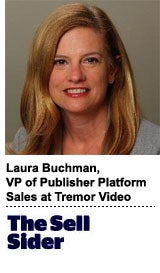 “The Sell Sider” is a column written by the sell side of the digital media community.
“The Sell Sider” is a column written by the sell side of the digital media community.
Today’s column is written by Laura Buchman, vice president of publisher platform sales at Tremor Video.
Premium publishers know that buying impressions through direct buys works, in spite of limited targeting options. An audience that fits a basic demographic requirement for advertisers is an adequate, safe and known value proposition.
Now the market is becoming increasingly programmatic, giving marketers the ability to more efficiently buy audiences at the impression level with far more specificity than in the past. Publishers need to participate in programmatic to grow their businesses, so they must get past the misconception that these types of data-driven strategies exclusively benefit advertisers while diminishing yield and the value of their inventory.
During any transitional moment, it’s always valuable to assess how traditional methods can blend with emerging opportunities. By integrating a hybrid programmatic approach with direct buys and demographic audience profiling, it is possible to balance a “tried-and-true” approach – offering valuable demographics that advertisers covet – with more data-informed methods that achieve higher yields and revenue for publishers.
By placing programmatic at the top of the waterfall – at a higher price point than a direct buy – and using a hybrid approach to intelligently use data across the private marketplace, publishers can produce more revenue and achieve better results for advertisers.
How The Hybrid Approach Works
Comedy Central is a publisher known to have a large audience of 18- to 34-year-old men. Gillette wants to target 18- to 34-year-old men who shave regularly. If Comedy Central charges a $40 CPM but never reveals how many in that pool are actually growing beards, Gillette would end up wasting a portion of that $40 CPM. The publisher is protecting its audience data but the advertiser is left wasting ad dollars.
However, if Comedy Central allows Gillette to blend its audience targeting with programmatic, Gillette can take its cookie pool, which can effectively target 18- to 34-year-old men, and separate out those who want to grow a beard. Comedy Central then can sell that inventory to another brand that offers beard-trimming products so it can target them at the $40 CPM. By blending the two types of data, there is virtually no wasted ad spend and Comedy Central is able to maintain premium pricing. Publishers get their yield and the individual advertisers eliminate waste to achieve more value from each impression.
This type of scenario works for any brand that is targeting a specific audience. For example, Glamour is a publisher known to have a large audience of college-age women who are 18 to 24 years old. Toyota may want to target car drivers within this group.
Glamour may sell its inventory and never reveal which women from its pool are drivers, resulting in wasted ad spend for Toyota. But when audience targeting and programmatic are blended, Glamour can enable Toyota to use its cookie pool and separate the women who drive from those who don’t. Glamour can then sell the remaining inventory to a brand targeting women who don’t drive. Voila! Goodbye wasted ad spend.
When publishers enable an extra layer of data insights, advertisers can create more relevant and targeted ads that they are willing to pay more for because they are inherently more valuable. By maintaining a high-end price point and enhancing a publisher’s inventory through the synchronization of cookies and first-party data, publishers can sell an audience of shavers and beard growers or drivers and non-drivers, at premium CPMs that are just packaged differently. This increases the total value of their inventory dramatically while affording brands the ability to do more with less.
Assigning The Right Value
Premium publishers view the value of their brand as having a direct correlation to the value of their audience. But the reality is the real revenue driver for a modern publisher is how much they can enable an advertiser to target better and more efficiently. There is a massive shift from IO-based ad buying to programmatic because advertisers want to move away from purchasing an audience of proxies and gambling with their ad dollars the way they used to.
When placing programmatic inventory at the top of the waterfall, the key to setting the pricing structure is to take a data-driven approach. Publishers should look at advertiser and user data to develop a keen understanding of the value proposition of their channels to shape pricing. Publishers can successfully price programmatic just as well, if not better, than direct. By segmenting and matching inventory with the right buyers, a publisher provides real value. Having a clear understanding of first-party data, what buyers are looking for and how context impacts performance can have an enormous impact on yield.
As buyers flock to programmatic because it allows them to adjust their campaigns on the fly and better target because they can buy on an impression level, consumers will see fewer irrelevant ads and have a better experience with digital content. At the same time, publishers will be able to drive higher CPMs using an added layer of data they can provide to buyers. If publishers are to grow their business in these changing digital times, they must put aside their fears of losing premium direct ad revenue. By putting programmatic at the top of the waterfall, at a higher price point than direct, they can offer a more intelligent, hybrid option to supplement direct buys with data that will drive results for advertisers.
Follow Tremor Video (@TremorVideo) and AdExchanger (@adexchanger) on Twitter.











